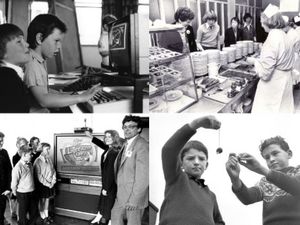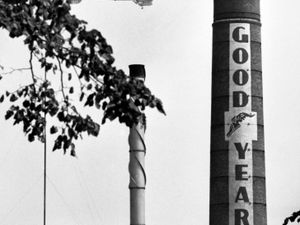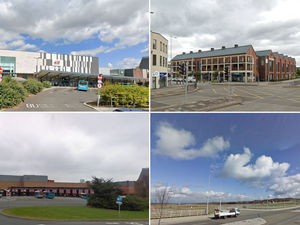Special feature with pictures and video: Life going underground in Shropshire
All gone now. The dirt, the din, and the toil, an underground way of life in Shropshire which has disappeared and is a fading memory but has left enduring physical scars in the landscape for those who still know where to look.
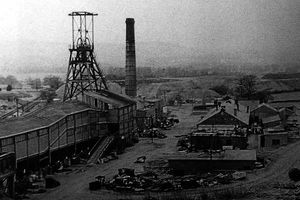
Colin Williams worked at one of the county's last mines to close – Ifton Colliery.
And it was an innocent question from his grandson Sam – "What is a colliery?" – which inspired him to act to bring Ifton's story to a wider audience through a three minute YouTube film.
It is a tribute to Denzil Jones, who was killed at Ifton, and to the other Ifton miners who "risked their lives and health for the wealth of this country" and showcases photographs of the colliery, the miners, and the tough colliery life.
Colin, who lives in Pant, did not know Denzil Jones personally but he dedicated the film to him after chatting to his daughter on Facebook.
"I have been retired for four years but started my working career at the age of 16 with the National Coal Board and signed up as an apprentice electrician at Ifton Colliery on July 12, 1965," he said.
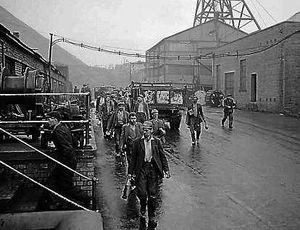
The last shift at Ifton came up at 10pm on November 22, 1968, after which the colliery closed.
Former spoil heaps are now a nature reserve which covers 20 hectares and is called Ifton Meadows.
Ifton was first sunk as the Gertrude Pit of Brynkinalt Colliery, owned by W.Y. Craig and Son, of Preesgweene, Oswestry. Eventually Brynkinalt ceased, and the men were transferred to Ifton Colliery.
The Gertrude name is said to have come from a female member of the Craig family variously said to be the mine managers wife or the owners daughter.
It was the largest colliery in Shropshire and workings extended into Wales.
Although the mine has gone, Ifton Colliery Band, established by local miners in 1916, still exists. It is based in St Martins and is a registered charity which plays at public events and functions.
The difference between a colliery and a pit is that a colliery encompasses the underground workings, together with the surface buildings and infrastructure, while a pit is an individual shaft. However, colloquially, they are used to mean the same thing.[/breakout]
"The headmaster of St Martins secondary modern school took me and two others for an interview at Gresford colliery training centre. There were over 100 other candidates for 50 apprenticeships, some electrical and some mechanical.
"The lucky lads who managed to get an apprenticeship spent the first three months at Gresford colliery training centre learning everything to keep you safe. Needless to say the instructors pointed out the place that was sealed off after the explosion on Saturday, September 22, 1934, killing 266 men and boys, including several of the rescue team.
"After the very basic training we went to the technical college in Wrexham where we studied everything from science to welding, technical drawing to blacksmith work. During holidays you returned to the respective colliery of your choice. During this time you went around the various departments, so there were many weeks in each section, for example the stores or lamp room and so on.
"After the first 12 months at technical college we went to the colliery of our choice, mine being Ifton."
Colin was introduced to the electrical workshop and the men who would teach him the ropes.
"Eventually the time would come when it was time to go down the pit for the first time – a somewhat frightening experience.
"I always hated the gap around the cage, thinking I might slip and fall down the shaft.
"Between 14 and 16 men would be crammed together in the cage with no room for movement.
"The cage would accelerate up to speed quickly giving you a feeling that the bottom of the cage was falling out, but after a few descents it became a normal procedure.
"Another disconcerting thing that I noticed was the cage was suspended by six substantial chains, all of which terminated onto a wire rope which didn't seem at all large enough.
"But I was assured that a rope had never snapped in the whole of the country."
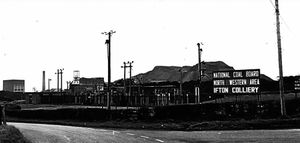
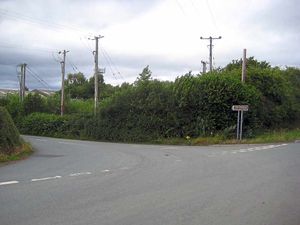
It was once a hive of industrial activity, the landmark entrance to the Ifton Colliery.
But now anyone would simply drive with no clue to the importance of the site, the corner a nondescript series of hedges like thousands of others in Shropshire.
All across our county there are remnants of old colliery sites as the work that once sustained generations of families have made way for other uses.
When Granville colliery, just east of Telford, closed in 1979, it drew down the curtain on an industry which had provided jobs for decades.
And had those Granville miners had the power to see what would happen at their workplace in the years that followed, they would have raised an eyebrow.
Today the hub of the former mine is the home of Telford Naturist Club, which has been there for over 30 years, a private oasis in the landscape. It has a heated outdoor pool, fully licensed bar, a sauna, and areas to laze to enjoy the sun – something miners would not see for hours on end.
The wider site of the old colliery is now largely fields and agricultural land, and there is also a huge and busy landfill site.
Other former collieries in Shropshire have similarly undergone transformations. Mining began at Highley in late Victorian times and workings were expanded under the river into Alveley. A new mine was later sunk in Alveley. Coal production ended at Highley in 1940, but the new Alveley pit, which became fully operational in 1939, flourished post-war.
However the mine at Alveley – confusingly, remembered by many as 'Highley Colliery' – closed on January 31, 1969.
In 1986 a reclamation scheme began, and in 1992 Severn Valley Country Park opened spanning land on both sides of the Severn. It is managed by Shropshire Council and attracts around 140,000 visitors a year to its network of paths and trails, visitor centre and picnic areas.
Meanwhile at another casualty of 1960s closures, the site of Ifton Colliery is now home to a range of businesses and there is also a nature reserve.
And these are just a fraction of the dozens of pits that were in the Shropshire landscape, many of them mining coal, but others driving underground to harvest other valuable minerals and metals, with the old Snailbeach Lead Mine now restored as a visitor attraction.
When he turned 18, he became eligible to work shifts. "When I first started going underground work began opening a new district close to the pit bottom.
"The old men used to say that it was a bad choice because there had been fires in that area before.
"But alas, this decision was made much higher up than at the pit, so work carried on regardless and after a few months of coal production a fire erupted and the district had to be sealed off to save the pit because the fire was so close to the pit bottom.
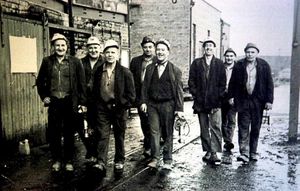
"This fire was used as one of the reasons for closing the pit, plus the loss of markets, which resulted in 134,000 tons of coal being stockpiled at the colliery surface. However, within two months of the closure the stock of coal had all been sold."
Pit life always had its dangers. There were the minor scrapes, but also the more serious accidents, and it was not long before young Colin had a very personal experience of the hazards.
"The electrician and me were asked to fetch the stretcher because one of the men drilling the top part of the coal seam ready for shot firing had been crushed when the coal broke away and fell on him, crushing his legs.
"We ran to get the stretcher some 50 yards away and took it down the face where the first aid men had already removed the rubble and put his legs in splints. It was only then I found out it was my uncle Harry.
"The most important part of this little story is to point out the importance of your mates and the bond between each other.
"There is no ambulance. Your only help is your mate. Everyone was taught first aid and firefighting, and everyone was expected to help each other and you would never, ever, pass someone who needed a lift."
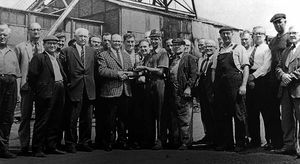
Then came word that Ifton was to close, due to loss of markets and the fire near the pit bottom.
"Sure enough, in October 1968 the notice came up that Ifton was to close in the December.
"I helped with salvage for a month, then I was transferred to Bersham colliery near Wrexham to complete my apprenticeship. I continued to work at Bersham until its closure in December 1986.
"Ifton Colliery, although in Shropshire, was in fact part of the North Wales coalfield which extends from Point of Ayr by Rhyl to near Oswestry.
"Ifton Colliery shaft was sunk in 1913 and became the main shaft for production and supplies and the old colliery, Brynkinalt at Chirk, became the ventilation shaft for Ifton. Ifton Colliery was originally called Gertrude Colliery, after a female member of the Craig family who founded it.
"If I remember correctly many of the older officials used the name Gertrude on their daily reports.
"It's 47 years since the pit closed. It was a big worry at the time, as most men had never worked anywhere else. To add to the worry there was the propaganda (just like now) that people who work in a nationalised industry are inefficient, idle and skivers and don't know what time of day it is.
"Fortunately in 1968 some effort was put in to secure jobs for the men made redundant and grants were given to Cadbury Ltd to open a factory in Chirk and a little later Kronospan, the woodchip company.
"The result of this was there were very few men left unemployed for very long. To the best of my knowledge all the men did well in their new jobs and most companies held them in high regard.
"It took a little while to alter, but without the community of the pit all the things that held the community together had gone.
"The men of the pit would organise clubs, it might be the darts team, fishing contests, racing pigeons, poultry shows, carnivals, Christmas parties, jazz band, St John first aid, and on and on. All gone – you wouldn't know the person ten doors down from you.
"I went back to the Ifton Colliery site not too long ago. There are new buildings, but I didn't see any actual manufacturing industry. There was heavy plant hiring firms, a lorry repair workshop and a scrap metal company, but at least there is something going on.
"It's hard to imagine that most of the men from Ifton Colliery must now be dead. I am 66 and was one of the youngest at the colliery when it closed."


